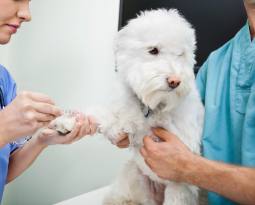Just like humans, pets can suffer from allergies that can significantly impact their quality of life. Pet allergies can manifest in various ways, including itching, skin irritations, gastrointestinal issues, and respiratory problems. Identifying and managing these allergies is key to ensuring your pet stays happy and healthy. In this blog, we’ll explore how to recognize common allergies in pets, how they are diagnosed, and effective treatments for managing these conditions.
Understanding Pet Allergies
Allergies occur when a pet’s immune system reacts abnormally to substances that are typically harmless. These substances, known as allergens, can come from a variety of sources such as food, environmental factors (like pollen or dust mites), or flea bites. While some pets may develop allergies early in life, others may not show symptoms until they are older. Allergies can affect both cats and dogs, and each pet may react differently to specific allergens.
Common signs of pet allergies include:
– Excessive itching or scratching
– Red, irritated skin or hot spots
– Ear infections or head shaking
– Sneezing or coughing
– Gastrointestinal issues such as vomiting or diarrhea
– Watery eyes or nasal discharge
If you notice any of these symptoms, it’s important to consult with your veterinarian to determine whether an allergy is the cause and to discuss the best course of treatment.
Common Types of Allergies in Pets
There are three primary categories of allergies that can affect pets: environmental allergies, food allergies, and flea allergies. Each type requires a different approach to diagnosis and treatment, so understanding the differences is essential to providing proper care.
1. Environmental Allergies (Atopy)
Environmental allergies are among the most common allergies in pets and are often caused by allergens like pollen, mold, dust mites, or grasses. Pets with environmental allergies may experience symptoms like sneezing, runny eyes, and constant itching, particularly around their paws, face, and ears. These allergies are often seasonal, but they can also occur year-round, depending on the allergen.
2. Food Allergies
Identifying pet allergies related to food can be challenging, as symptoms often overlap with other types of allergies. Common food allergens in pets include beef, chicken, dairy, and grains. Symptoms of food allergies often include digestive problems like diarrhea or vomiting, as well as skin conditions like hives, rashes, or chronic ear infections. A food allergy can develop at any time, even if your pet has been eating the same food for years without issue.
3. Flea Allergies
Flea allergy dermatitis is another common condition, especially in dogs and cats with flea infestations. Pets with flea allergies are hypersensitive to flea saliva, and a single flea bite can cause severe itching and irritation. Pets may excessively scratch or bite their skin, leading to hair loss, scabs, or hot spots. This type of allergy can also result in secondary bacterial infections due to the constant scratching.
Identifying Pet Allergies
Identifying pet allergies can be a complicated process because the symptoms often mimic other health issues. The first step in determining the cause of your pet’s allergies is a thorough veterinary examination. Your vet may use several methods to diagnose allergies, including:
Skin Tests: For environmental allergies, your vet may recommend skin testing, where small amounts of allergens are introduced into the skin to observe reactions.
Blood Tests: Blood tests can be used to detect the presence of antibodies to specific allergens.
Elimination Diet: If a food allergy is suspected, your vet may suggest an elimination diet, where your pet is placed on a hypoallergenic diet for several weeks to see if symptoms improve. The previous diet is then reintroduced to see if the symptoms return, confirming a food allergy.
Flea Control: If flea allergies are suspected, strict flea control measures will be implemented to determine if symptoms improve with flea elimination.
Proper diagnosis is crucial in determining the best allergy treatment for pets. Without identifying the allergen, treatment may only address the symptoms without resolving the underlying issue.
Treating Pet Allergies
Once an allergy has been identified, your veterinarian will recommend a treatment plan tailored to your pet’s specific condition. Treating pet allergies typically involves a combination of strategies aimed at both managing symptoms and reducing exposure to allergens.
1. Environmental Allergy Treatments
For pets with environmental allergies, reducing exposure to allergens can help alleviate symptoms. This might include frequent baths to remove pollen and other irritants from their coat, using air purifiers to reduce indoor allergens, and cleaning bedding regularly. Additionally, your vet may prescribe antihistamines, corticosteroids, or immune-modulating drugs to help control the allergic response.
In more severe cases, allergy treatment for pets may include allergy shots (immunotherapy). This involves exposing the pet to gradually increasing doses of the allergen to desensitize the immune system over time. Immunotherapy is often used for pets with chronic or severe environmental allergies that don’t respond well to other treatments.
2. Food Allergy Treatments
For food allergies, the main treatment is dietary management. Once the offending ingredient is identified, it must be permanently removed from your pet’s diet. Many pets with food allergies thrive on a hypoallergenic or limited-ingredient diet. It’s important to carefully read labels and avoid giving your pet any treats, chews, or human foods that contain the allergen.
A strict diet may require time and patience, but it can greatly improve your pet’s quality of life by reducing the frequency and severity of allergic reactions.
3. Flea Allergy Treatments
The best way to manage flea allergies is through consistent flea prevention. Your vet may recommend topical treatments, oral medications, or flea collars to prevent flea bites. It’s also important to treat your pet’s environment, including their bedding and living spaces, to prevent re-infestation.
For pets experiencing severe flea allergy dermatitis, anti-itch medications, steroids, and antibiotics may be necessary to treat the symptoms and any secondary infections.
Home Care for Allergies in Pets
In addition to veterinary treatments, there are several steps pet owners can take at home to help manage common allergies in pets. Regular grooming, including baths and brushing, helps remove allergens from your pet’s skin and coat. Washing your pet’s bedding, vacuuming frequently, and using air filters can help reduce allergens in the home.
For pets with food allergies, be vigilant about their diet and avoid introducing new foods without consulting your vet. Stick to a consistent feeding routine and monitor any changes in behavior or health after meals.
Allergies can be a frustrating experience for both pets and their owners, but with proper care, most pets can live comfortably with their allergies. Identifying pet allergies early on and working with your veterinarian to create a treatment plan is essential to managing the condition. Whether it’s food, environmental, or flea-related, treating pet allergies involves reducing exposure to allergens and providing medical care as needed.
By staying informed and proactive, you can help your pet live a happier, healthier, and itch-free life despite their allergies. Always consult your vet for the best course of action, and don’t hesitate to reach out if you notice any changes in your pet’s health or behavior.







